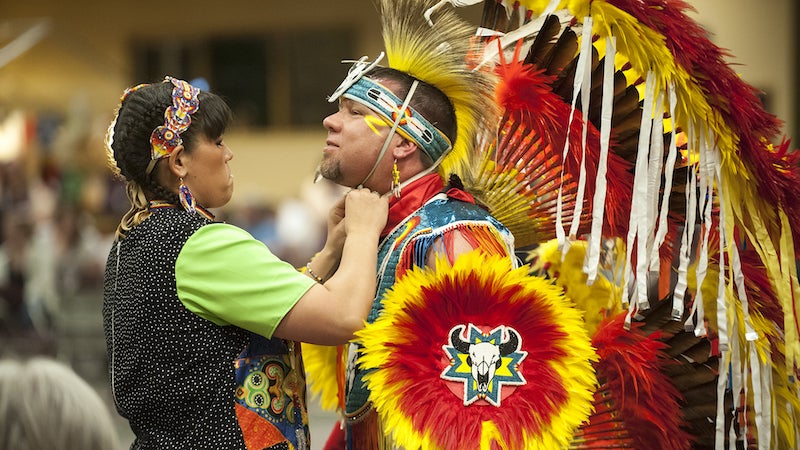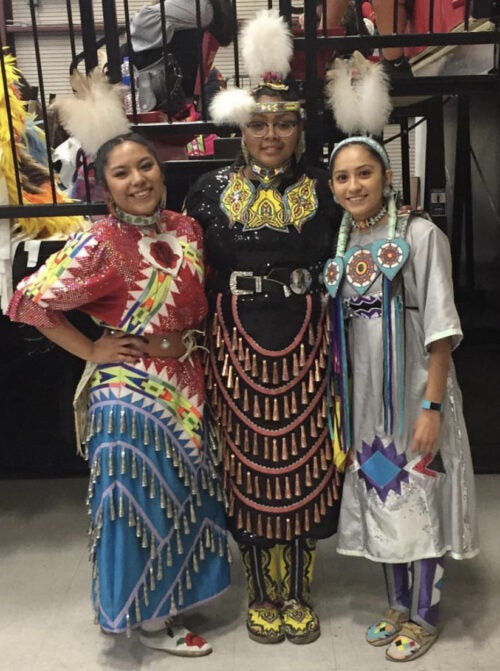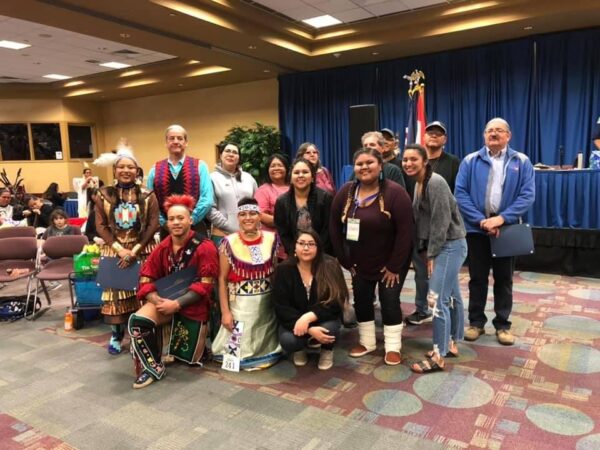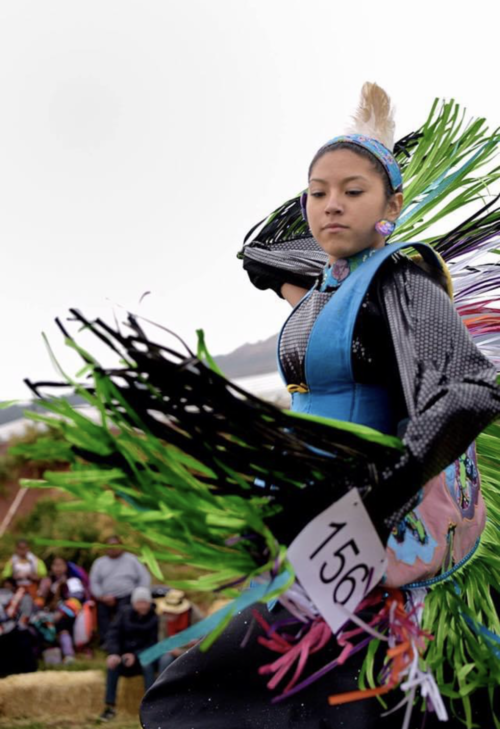
Culture. Celebration. Community. That’s what you’d see if you walked into a powwow. You’d see a large gathering of Indigenous people of Native American tribes from as far as Canada to the East Coast. You’d see them dressed in colorful regalia, their hair slicked back into braids, and their faces adorned with makeup and elated expressions. You’d see young and old, dancing joyfully, embracing their culture. You’d hear the loud cheering and singing — the sound of tribes coming to together to celebrate their indigenous heritage.
On March 30 – 31, 2023 the annual Seven Arrows Powwow will be held in the Extra Mile Arena. Boise State students can attend for free with a student ID to experience Native American culture. You can even sign up to volunteer.
In the nineteenth century, powwows “became homecoming celebrations, when families and communities separated by government removal could reunite,” according to the Smithsonian Institution. Today, powwows are held regularly all over the United States.
Barbe Tom, an alumn of Boise State and a member of the Te-Moak Western Shoshone, shared her story of building a legacy for native communities with Student Life last year.
“[The Powwow] was an opportunity that opened up to participate in my culture, because it’s not very common out here,” Barbe said.

She was an active member of the Intertribal Native Council during college. Now that she’s graduated, Barbe steps in to help with events when needed but lets current students take the reins to make the council and the events they put on their own.
“Being a participant and now being on the other side, there’s a certain appreciation.”
The Intertribal Native Council is a student-driven organization that supports Native American students of all backgrounds, socializes with them, and creates cultural events, including the Seven Arrows Powwow. Barbe’s grateful for the persistent friendships that being a part of the council created for her. She recalls meetings where they laughed, chatted, and had fun before getting down to business. She’s continuously impressed by what the students create since she recognizes the hard work that goes into getting an important event off the ground.
“It’s amazing what we could pull together because most of us always grew up in some aspect of our culture, but again, we come from such different groups that we had to come together to find out, ‘How do you do this? How do you do that?’ and we had to meet in the middle.”
Tanyka Begaye, the Orientation and First Year Support Coordinator for Admissions and New Student Programs, has helped the student organization plan for the powwow since 2017. “Each person has their own preference, so each year things are done in different styles but the foundation remains the same.”

Overcoming Challenges
With the help of her sister, she played a part in keeping the Seven Arrows Powwow going and became heavily involved until it had to be canceled in 2020 due to COVID-19. “We had been to many Powwows before and were slightly knowledgeable about how to plan one but it was a new experience to figure out how to plan one at Boise State.”
A challenge the Intertribal Native Council has to overcome is abiding by the rules of the university while preserving its own long-standing traditions. They have to plan carefully because, with one misstep, their powwow could be shut down.
“As indigenous people, [we] have to be mindful that we’re not in our own community and that we have to cooperate with the outside community.”
Barbe explained that the university doesn’t allow smoke on the premises, which interferes with an important aspect of powwow tradition: smudging. This is the act of prayer to bless the grounds that an event is held on to cleanse the area of negative thoughts to keep the participants stay healthy and safe.
“Even if we have bad thoughts and bad intentions, it can make other people sick.”
What to expect
Powwows are traditionally a come-and-go-as-you-please affair to allow people the option of enjoying dancing and singing and having a good time on their timeline. However, university policies require a detailed schedule and timeline of events so, accommodations have to be made.
The typical powwow agenda looks something like this:
- Praying to the Creator
- Grand entry
- Intertribals
- Competitions, specials, and dancing
- Retiring the flags (salutation)
On the invitation, you can find event details such as admission, parking, and competition information.
On Saturday night, the participants go all out with their regalia and makeup and get ready to dance. Competitions are broken into age categories from tiny tots to elders. There are different styles for each gender: Men’s styles are grass, fancy, and traditional, and women’s styles are jingle, fancy, and traditional. Special categories with a side prize are also announced.
“We’re doing the best we can with the resources we have, so there is an appreciation of making sure our culture is kept alive, and that it’s kept authentically.”
Barbe, who has been dancing in powwows since she was 3 years old, said her favorite part of the powwow is prepping for the festivities. She remembers feeling the adrenaline rush while getting ready, knowing it’s going to be a busy, but memorable weekend full of celebration, and competition.

A community of respect
“I’d say the purpose of a Powwow is to heal, rejuvenate, and gather relatives and the community,” Tanyka said. “As Native American people, we often say this is where we go to receive good medicine because it is the space to heal and rejuvenate. It’s also a place where we can come to be in and with community and have time to relax and enjoy.”
Barbe emphasized that when powwows are open to the public, one shouldn’t be intimidated but have an open mind and a respectful attitude. They just want to make sure that everyone is having a good time at the celebration.
To combat the negative conception that attending a public powwow means you’ll get dragged into participating in something you don’t want to, Barbe lightheartedly said, “The only thing you’re going to get dragged into is a joke.” Laughter is the best medicine.
“It’s definitely scary to walk into a big, and in this case loud, area. I think just know you’re always welcome as long as you’re respectful.”
Not all Native American tribes are alike. Respect is the central value when members of different indigenous tribes interact with each other. They ask thoughtful questions to understand each other and avoid overstepping or unknowingly disrespecting someone else’s culture. They’re open to learning about each other’s culture, approach each other with kindness, and are conscientious of preserving different Native American cultures while putting on an inclusive event.
Natives are very spiritual people who see their belongings being touched as a way to pass on negative thoughts. Touching people’s sacred items, regalia, jewelry, or hair is disrespectful. Mocking singers that do war calls that have genuine meaning behind them is disrespectful. Those attending need to know that they’re attending a powwow, they’re sharing their bubble with another culture.
From listening to Barbe and Tanyka describe their beloved Native American culture, I could tell that every activity, decision, and interaction during a powwow is intentional. Indigenous people care deeply about their heritage and work together to preserve it — though it comes with challenges. They encourage others to enter the Seven Arrows Powwow with respect, kindness, and an open mind because it’s worth getting a glimpse into their culture.
Author
-

Molly
Content Writer